CAA News Today
News from the Art and Academic Worlds
posted by Christopher Howard — June 26, 2013
Each week CAA News publishes summaries of eight articles, published around the web, that CAA members may find interesting and useful in their professional and creative lives.
Humanities Committee Sounds an Alarm
A new national corps of “master teachers” trained in the humanities and social sciences and increased support for research in “endangered” liberal-arts subjects are among the recommendations of a major report delivered last week on Capitol Hill. The report comes amid concern about low humanities enrollments and worries that the Obama administration’s emphasis on science education risks diminishing a huge source of the nation’s intellectual strength. (Read more in the New York Times.)
The Humanities “Crisis”—Are Museums and Higher Education Doing All They Can?
Our public museums and libraries and our colleges and universities occupy a privileged cultural space and have earned respect born of their missions to foster and disseminate knowledge. By historical standards, public museums and libraries have been open institutions, and more people than ever are taking advantage of higher education. But what is possible in terms of scale and what constitutes “open” have moved fast and far recently. To date, most museums, colleges, and universities have not yet embraced the radical expansion to their missions that is now possible. (Read more in e-Literate.)
Do Unpaid Internships Lead to Jobs? Not for College Students
The common defense of the unpaid internship is that, even if the role doesn’t exactly pay, it will pay off eventually in the form of a job. Turns out, the data suggests that defense is wrong, at least when it comes to college students. For three years, the National Association of Colleges and Employers has asked graduating seniors if they’ve received a job offer and if they’ve ever had either a paid or unpaid internship. And for three years, it’s reached the same conclusion: unpaid internships don’t seem to give college kids much of a leg up when it comes time to look for employment. (Read more in the Atlantic.)
What Job-Placement Data Would Be Useful?
What data on the job placement of PhDs would be most useful to prospective graduate students and job candidates? “Any data at all,” came the reply from one respondent to an informal survey on graduate-school placement. The sense of frustration with the lack of reliable information was clear in the responses. The survey asked, “What data would be the most useful to you on the job-placement rates of individual PhD programs?” One respondent replied, “honest data; no lies.” Another wrote: “Any data would have been nice. I was given the impression that a PhD would lead to a job, but now I know that isn’t the case at all.” (Read more in the Chronicle of Higher Education.)
Half of Faculty Say Their Job Is More Difficult Today Than Five Years Ago
If you find yourself working longer hours or maybe feeling a bit more stressed at the end of the day, you’re not alone. Fifty percent of college faculty who completed the annual Faculty Focus reader survey said that their job is more difficult than it was five years ago. Only nine percent said their job is less difficult, while 33 percent said it’s about the same. (Read more in Faculty Focus.)
Arts and Culture Was Fastest-Growing Philanthropic Cause in 2012
Arts and culture was Americans’ fastest-growing charitable cause in 2012, rising an estimated 7.8 percent to $14.44 billion, according to a leading annual research report on charitable giving. Donations to education rose second fastest, with a 7 percent gain, according to the latest edition of Giving USA, issued last week by the Chicago-based Giving Institute and its research partner, the Lilly Family School of Philanthropy at Indiana University. (Read more in the Los Angeles Times.)
Help Desk: Getting Schooled
I’m an artist in my mid-twenties who has absolutely no formal education. So far I’ve managed to be fairly happy with small but very meaningful visibility, knowing that art making is about process and that it takes time to find one’s self. But I’m starting to hit a wall regarding the growth of my practice and am worried that my lack of “training” might be the problem, so I’m considering going to art school. How important do you think education is in order for someone to be or to become a professional artist? (Read more in Daily Serving.)
Art Museums Better Hurry Up and Get Ready for the Future of 3D Printing
In his living room in San Diego right now, Cosmo Wenman has two life-sized reproductions of the British Museum’s Head of a Horse of Selene, a magnificently lifelike sculpture with flared nostrils that dates to about 432 BC. The original in Britain is made of marble, about three feet end to end. Wenman’s copies, created with an older digital camera and a MakerBot 3D printer, are clearly reproductions as soon as you lift them up. Created in plastic and coated in a bronze patina, they weigh about eight pounds each. (Read more in the Atlantic.)
Contribute to the Art Bulletin Publication Fund
posted by Christopher Howard — June 25, 2013
 As you may already know, 2013 marks the one hundredth anniversary of The Art Bulletin, CAA’s first print publication and a preeminent scholarly journal for the history of art and visual studies. The Art Bulletin covers the full range of art history in essays by some of the world’s most acclaimed scholars of art. Essays from The Art Bulletin have been staples in art-history courses at colleges and universities for decades, and the journal continues to support exemplary scholarship in all areas of art history.
As you may already know, 2013 marks the one hundredth anniversary of The Art Bulletin, CAA’s first print publication and a preeminent scholarly journal for the history of art and visual studies. The Art Bulletin covers the full range of art history in essays by some of the world’s most acclaimed scholars of art. Essays from The Art Bulletin have been staples in art-history courses at colleges and universities for decades, and the journal continues to support exemplary scholarship in all areas of art history.
In honor of this important anniversary, CAA invites you to make a contribution to the Art Bulletin Publication Fund. Contributions of $50 or more made before July 1, 2013, will be acknowledged with a special thank you in the September issue, and contributions of $250 or more will be acknowledged in four consecutive issues and on the CAA website for twelve months.
Please join CAA in celebrating The Art Bulletin’s longstanding excellence as a leader in art-historical scholarship. We look forward to many years to come.
Propose a Session for the 2015 Annual Conference in New York
posted by Lauren Stark — June 24, 2013
 CAA invites individual members to propose a session for the 103rd Annual Conference, taking place February 11–14, 2015, in New York. Proposals should cover the breadth of current thought and research in visual art, art and architectural history, theory and criticism, pedagogical issues, museum and curatorial practice, conservation, and developments in technology. For full details on the submission process for the conference, please review the information published on the Chair a 2015 Annual Conference Session webpage.
CAA invites individual members to propose a session for the 103rd Annual Conference, taking place February 11–14, 2015, in New York. Proposals should cover the breadth of current thought and research in visual art, art and architectural history, theory and criticism, pedagogical issues, museum and curatorial practice, conservation, and developments in technology. For full details on the submission process for the conference, please review the information published on the Chair a 2015 Annual Conference Session webpage.
The Annual Conference Committee welcomes session proposals from established artists and scholars, along with those from younger scholars, emerging and midcareer artists, and graduate students. Particularly welcome are proposals that highlight interdisciplinary work. Artists are especially encouraged to propose sessions appropriate to dialogue and information exchange relevant to artists.
The submission process for the 2015 conference is now open. In order to submit a proposal, you must be a current CAA member. Deadline extended to Tuesday, September 10, 2013.
Image: A. Major, Bird’s-Eye View of the Great New York and Brooklyn Bridge, and Grand Display of Fireworks on Opening Night … May 24, 1883, 1883, color lithograph, 18⅞ x 26¼ in. Metropolitan Museum of Art, New York (artwork in the public domain)
Solo Exhibitions by Artist Members
posted by CAA — June 22, 2013
See when and where CAA members are exhibiting their art, and view images of their work.
Solo Exhibitions by Artist Members is published every two months: in February, April, June, August, October, and December. To learn more about submitting a listing, please follow the instructions on the main Member News page.
June 2013
Abroad
Sam Durant. Museo d’arte contemporanea Roma, Rome, Italy, April 23–September 8, 2013. La stessa storia.
Midwest
Hartmut Austen. Art Building West Gallery, University of Iowa, Iowa City, Iowa, April 16–21, 2013. Grant Wood Fellowship Exhibition. Drawing and painting.
Margi Weir. Kishwaukee College Art Gallery, Malta, Illinois, October 22–November 15, 2012. Margi Weir: Observations and Innuendos. Painting and drawing.
Northeast
Fredericka Foster. Fischbach Gallery, New York, April 25–May 25, 2013. Water Way. Painting.
Ben Grasso. Thierry Goldberg Gallery, New York, June 9–July 14, 2013. Ben Grasso. Painting.
Katerina Lanfranco. Nancy Hoffman Gallery, New York, June 20–August 2, 2013. Wildflowers and Floating Worlds. Mixed-media installation, painting, and sculpture.
Carrie Moyer. Frances Young Tang Teaching Museum and Art Gallery, Skidmore College, Saratoga Springs, New York, January 26–May 19, 2013. Carrie Moyer: Pirate Jenny. Painting.
Jim Osman. Lesley Heller Workspace, New York, March 10–April 14, 2013. Jim Osman: Stack. Sculpture.
Tim Ripley. Denise Bibro Fine Art, New York, April 4–May 11, 2013. Soft Cell. Painting.
Jaune Quick-to-See Smith. Accola Griefen Gallery, New York, February 28–April 6, 2013. Water and War. Painting.
Ann Tarantino. Mixed Greens, New York, March 21–May 24, 2013. Topoanalysis. Installation.
Dannielle Tegeder. Ruth and Elmer Wellin Museum of Art, Hamilton College, Clinton, New York, May 11–July 28, 2013. Dannielle Tegeder: Painting in the Extended Field. Painting, drawing, sculpture, and installation.
Idelle Weber. Hollis Taggart Galleries, New York, March 28–April 25, 2013. Idelle Weber: The Pop Years. Painting, sculpture, collage, watercolor, and gouache.
Idelle Weber. David Findlay Jr. Gallery, New York, March 1–30, 2013. Have It All! Painting.
South
Michael Aurbach. McIlroy Gallery, Mattie Kelly Arts Center, Northwest Florida State College, Niceville, Florida, June 10–July 19, 2013. Work by Aurbach: New and Used. Sculpture.
Kelly Sturhahn. 6th Street Container, Miami, Florida, May 17–July 14, 2013. Transient Patterns. Installation and work on paper.
Margi Weir. York County Center for the Arts, Rock Hill, South Carolina, March 22–April 28, 2013. Social Fabric: Works by Margi Weir. Painting, drawing, and vinyl installation.
West
Julie Green. Jordan Schnitzer Museum of Art, University of Oregon, Eugene, Oregon, March 1–April 7, 2013. Julie Green: The Last Supper. Painted porcelain plates.
Hazel Antaramian Hofman. Armenian Museum, Fresno, California, March 21–August 30, 2013. Repatriation and Deception: Post World War II Soviet Armenia. Painting and drawing.
Michael Ryan. The Lab, San Francisco, California, February 22–March 30, 2013. Mere Reflections. Painting and sculpture.
Call to Action by the Commission on the Humanities and Social Sciences
posted by CAA — June 20, 2013
At the end of a day-long presentation on June 21st, a group of 200 academic corporate and government leaders gathered in the Capitol Atrium to hear “The Heart of the Matter,” a new report created by members of the Commission on the Humanities and Social Sciences and supported by members of Congress about their personal and professional views on the value of the humanities. The three major goals of the report are to increase the literacy and knowledge of history for all Americans to help build better citizens; to invest in research and teaching; and to expand international cultural knowledge and awareness through the study of languages and international study.
The report addresses the hardest hit disciplines of language and literature as well as the drastically underfunded Fulbright Fellowship programs. Actor John Lithgow cited Senator Fulbright, a champion of the international education program that has benefitted thousands of students and enriched the country in incalculable ways, for a relatively small government investment. The report also calls for greater interactivity and communication between academics and the public and for open access to research. John W. Rowe, cochair of the Commission and retired Chairman and Chief Executive Officer, Exelon Corporation, urged everyone in the humanities to get out in their communities, cities, and states to advocate the value of the humanities. David Brooks, New York Times reporter and PBS commentator, addressed the communication gap between academia and the public. He stated his belief that in the past the humanities’ importance and relevance in society suffered amid the turn toward political, gender, and race issues that severed dialogue between academia and the public, and turned attention away from the core value of the humanities.
The Commissioners, who are leaders in the corporate, academic, legal, governmental, and philanthropic communities, focused on the value, need for support, and societal applications of the humanities and social sciences. The two recurring themes in the presentations extolled the wisdom of America’s founders who, as Senator Lamar Alexander quoted from the writer David McCullough, were “marinated in the humanities.” And almost every presenter recalled the transformative experience of their own college humanities courses. Pauline Yu, President of the American Council of Learned Societies stated that the country flourishes when it follows the example of its founders. Senator Karl Eikenberry, former U.S. Ambassador to Afghanistan and retired U.S. Army Lieutenant General, cited the need for more informed historians to warn the government against overreaching internationally. He characterized the humanities and social sciences as a wellspring of soft power.
Richard Broadhead, President of Duke University and cochair of the Commission, believes that the major issue facing the country today is how to bring the greatest number of people to reach their fullest abilities. He sees the current discussions about education as narrowing the issues to pragmatic concerns; parents, for example, might say that they do not want their children to study the humanities instead of science, technology, engineering, and math (STEM disciplines). Broadhead pointed out that the humanities and STEM disciplines are not at opposition but are interrelated and integrated. This concept was, in fact, graphically presented in a promotional film made by Ken Burns and George Lucas which used the image of a stem (read STEM) of a flower (read the humanities).
The report calls for support for the humanities from all sectors of the country, and the program provided many strong arguments to use, value, and nurture them. The hope is that this dialogue will continue on Capitol Hill to restore funding, and that it will provide greater exchange between the academy and the public for greater understanding of the importance of the humanities. Lithgow said he sensed a fresh breeze of bipartisanship that wafted through the Capitol yesterday with the focus on the humanities.
The report does not specifically address the visual arts, but it does address a greater focus on research and teaching in higher education. In the last four years there has been greater national emphasis on K-12 education and this report may assist in bringing the national dialogue around to higher education federal funding. The concept of a Culture Corps similar to AmeriCorps could serve to bring greater public access to the humanities and greater public-academic interchange. And, it could also provide the bridge between graduate school and the career path for students in the humanities. The report is a good catalyst for discussion and change. Let’s hope that the “fresh breeze” continues.
Report Warns against Declining Emphasis on Humanities and Social Sciences
posted by Christopher Howard — June 19, 2013
 Democratic and Republican lawmakers in Washington, DC, turned a spotlight on the urgent need to refocus the country on maintaining national excellence in the humanities and social sciences—and how failure to do so will have consequences at home and abroad for the future of American education, security, and competitiveness.
Democratic and Republican lawmakers in Washington, DC, turned a spotlight on the urgent need to refocus the country on maintaining national excellence in the humanities and social sciences—and how failure to do so will have consequences at home and abroad for the future of American education, security, and competitiveness.
Senators Lamar Alexander (R-TN) and Mark Warner (D-VA) and Representatives Tom Petri (R-WI) and David Price (D-NC) came together on Capitol Hill this morning to accept a report, prepared at their request, by the Commission on the Humanities and Social Sciences of the American Academy of Arts and Sciences.
Today’s release of the report, titled The Heart of the Matter, launches a national conversation about the importance of the humanities and social sciences to America’s future. Presented by the commission’s cochairs—Richard H. Brodhead, president of Duke University, and John Rowe, retired chairman and chief executive officer of Exelon Corporation—the report looks at the vital role of the humanities and social sciences in preparing and sustaining Americans for the responsibility of productive citizenship in the United States and the world.
The Heart of the Matter focuses on five areas of concern: K–12 education; two- and four-year colleges; research; cultural institutions and lifelong learning; and international security and competitiveness. It also makes recommendations to achieve three goals:
1. Educate Americans in the knowledge, skills, and understanding needed to thrive in a twenty-first-century democracy:
- Invest in the preparation of citizens with a thorough grounding in history, civics, and social studies
- Increase access to online resources, including teaching materials
2. Foster an innovative, competitive, and strong society:
- To ensure the vibrancy of humanities and social-science programs at all levels, philanthropists, states, and the federal government should significantly increase funding designated for these purposes
- Create a Humanities Master Teacher Corps to complement the STEM Master Teacher Corps recently proposed by the White House
3. Equip the nation for leadership in an interconnected world:
- Develop a “Culture Corps” that would match interested adults (retirees, veterans, artists, library and museum personnel) with schools, community centers, and other organizations to transmit humanistic and social-scientific expertise from one generation to the next
- Expand education in international affairs and transnational studies
“The American character is defined not by ethnicity—Americans come from many countries, races, religions, and cultures—but by a common set of ideals and principles that unite us as a country,” said Senator Alexander. “Those ideals and principles have always been shared and learned through the study of history, philosophy, and literature, but today their study is at risk. This report is a first step to highlighting the importance of, and ensuring a future for, our nation’s humanities education—and our unique American character as well.”
Senator Warner added, “I commend all the members of the commission for their hard work on The Heart of the Matter. Having a strong knowledge of civics, comprehensive reading and writing skills, and an appreciation of history are important for a well-rounded member of the twenty-first-century world. We must use this report as a foundation to continue to engage with the public on how best to keep our humanities and social sciences robust.”
Congressman Petri noted, “Knowledge and promotion of the humanities and social sciences are absolutely important so that citizens have a firm understanding of our nation’s unique history, culture, and heritage. I hope the recommendations in this report will be seriously considered to improve the teaching and understanding of the humanities and social sciences.”
“The humanities and social sciences help us understand where we’ve come from and who we are as a people, and that understanding points us toward the endeavors we must undertake to help every person reach their full potential,” said Representative Price. “Studies in these areas are critically important to a well-rounded education and the future of our country. This report comes at a crucial moment, and I hope it will help raise the profile of the humanities, provide a better understanding of their value, and spur a national conversation about how the humanities and social sciences keep our nation strong and competitive.”
“Today’s leaders in business, government, the military, and diplomacy must be able to analyze, interpret, communicate, and understand other cultures,” said Brodhead, cochair of the commission. “This report will remind Americans that a broad-based and balanced education, integrating the sciences, the humanities, and the social sciences, is the best way to equip our citizens to approach the complex problems of our rapidly changing world.”
“The humanities and social sciences comprise many of the things that give life meaning,” said commission cochair Rowe, “both at the highest level and in our day-to-day activities. They need more public and private support and compared to other things a little money goes a long way.”
A short companion film, The Heart of the Matter, from the Emmy Award–winning Ewers Brothers Productions was also released today. Appearing in the film are the producer, screenwriter, and director George Lucas, the actor John Lithgow, the cellist Yo-Yo Ma, and the documentary filmmaker Ken Burns.
The Andrew W. Mellon Foundation, a steadfast supporter of the humanities and arts in this country, provided primary funding for the Commission on the Humanities and Social Sciences. The Carnegie Corporation of New York also provided important funding.
The views expressed in the report are those of the Commission on the Humanities and Social Sciences and not necessarily those of the officers and fellows of the American Academy of Arts and Sciences.
News from the Art and Academic Worlds
posted by Christopher Howard — June 19, 2013
Each week CAA News publishes summaries of eight articles, published around the web, that CAA members may find interesting and useful in their professional and creative lives.
The New World of Net Art
When internet art first emerged in the early 1990s, it was regarded as something that dealt almost exclusively with the architecture of the World Wide Web itself. During that period, the German-born Wolfgang Staehle constructed The Thing, an electronic bulletin-board system that served as a forum for discussions about and dissemination of what was referred to as “net art.” But as the web has evolved, so too has the notion of what might be considered internet art. (Read more in ARTnews.)
Internet Real Estate, Art, and Power: The Cases of Artsy and .art
The forthcoming introduction of generic top-level domains—which will replace the .com or .net suffix with specific words or terms, such as .food, .movies, or .microsoft—poses new speculative opportunities as dizzying as those of Zola’s nineteenth-century Paris. Last year, e-flux announced that it had applied to manage the proposed .art domain. The application fee alone was $185,000, and the successful applicant will pay ICANN a further $25,000 per year. There is clearly money to be made in top-level domains, but the management of .art may be more than a business; it holds within it the power to act as gatekeeper. (Read more from Rhizome.)
2011: Michael Sanchez on Art and Transmission
Are we living in an aftermath? The unspoken consensus seems to be that, in relation to the art of the previous decade, the early 2010s are a caesura—a waiting period at best, analogous to the early 1970s in relation to the ’60s, or the early ’90s in relation to the ’80s. Those older historical moments were not just lulls, however, but scenes of profound discursive and technological mutation. And likewise, over the past few years, a set of technical innovations have arisen that have reconfigured conditions for the production and distribution of art. (Read more in Artforum.)
Smart Phones and Academic Research
For academics, smart-phone cameras can be used to gather and document information during field research, augment presentations, and connect to a wider audience through the myriad of communities online. Scholars in fields as different as clinical medicine and art are using smart-phone technology to not only aid in research, but also to share their findings with people who would not otherwise be engaged with their academic research. (Read more in Just Publics @365.)
Google Leads Search for Humanities PhD Graduates
Those worried about the value of studying the arts and humanities, particularly at the postgraduate level, take heart: Google wants you. In a boldly titled talk at a recent conference at Stanford University, Damon Horowitz, director of engineering—and in-house philosopher—at Google, discussed the question of “Why you should quit your technology job and get a humanities PhD.” (Read more in Times Higher Education.)
Connoisseurship, Physics Envy, and the Wages of Error
What is the nature of connoisseurship as a form of knowledge, and how precisely does it differ from other fields? To what special forms of cognitive error is it prone? What does the art historian do to arrive at an attribution when there is no evidence to go on other than what is before our eyes? (Read more from Neil Jeffares.)
Learning from Taksim Square: Architecture, State Power, and Public Space in Istanbul
In a matter of days, “Taksim Square” has become a household name akin to Tahrir Square, shorthand for a youthful protest movement against the brutality of state power in the Middle East. What began as a peaceful sit-in to protest the uprooting of trees from Gezi Park, one of Istanbul’s last open green spaces near Taksim Square, has morphed into a broader Occupy movement against the Turkish government. For an architectural historian, it is no accident that the great plans to remake Taksim, as well as the protestors’ speeches and actions, often invoke history and architectural memory to buttress their arguments in the present. (Read more in the SAH Blog.)
Just Look at the Data, If You Can Find Any
Advisers and prospective students need something more than a scattered helping of infrequently updated best-case scenarios. We need externally verified, reasonably comprehensive data about individual programs and maybe even individual advisers. Aggregated data about graduate schools have limited usefulness when individual programs have such variability in their placement outcomes. Also, aggregated data place little pressure on individual universities to reform themselves. (Read more in the Chronicle of Higher Education.)
caa.reviews Publishes Dissertations Completed and In Progress for 2012
posted by Alyssa Pavley — June 18, 2013
caa.reviews recently published the authors and titles of doctoral dissertations in art history and visual studies—both completed and in progress—from American and Canadian institutions for calendar year 2012. You may browse by listing date or by subject matter. Each entry identifies the student’s name, dissertation title, school, and advisor.
Each institution granting the PhD in art history and/or visual studies submits dissertation titles once a year to CAA for publication. The caa.reviews list also includes dissertations completed and in progress between 2002 and 2011, making basic information about their topics available through web searches.
Recent Deaths in the Arts
posted by Christopher Howard — June 18, 2013
In its regular roundup of obituaries, CAA recognizes the lives and achievements of the following artists, designers, scholars, professors, museum directors, and others whose work has significantly influenced the visual arts. Notable deaths this month include the former Guggenheim Museum director Thomas M. Messer and a dealer, curator, and publisher of Conceptual art, Seth Siegelaub.
- Cerna “Chickie” Alter, a corporate art consultant who established her Chicago-area business in the 1960s, died on May 10, 2013. She was 74
- Ralph Brown, a British sculptor of figurative works in clay, plaster, metal, and marble, died on April 3, 2013, at age 84
- Anne Bryan, an artist and a student of painting at the Pennsylvania Academy of the Fine Arts in Philadelphia, died on June 5, 2013. She was 24 years old
- William T. Cartwright, a documentary filmmaker and producer who bought and preserved the Watts Towers in Los Angeles, died on June 1, 2013. He was 92
- Roberto Chabet, a curator and the founding director of the Cultural Center of the Philippines who taught for more than thirty years in the College of Fine Arts at the University of the Philippines, died on April 30, 2013. Known as the father of conceptual art in his country, he was 76 years old
- Niels Diffrient, an industrial designer who worked on the Princess telephone, John Deere tractor seats, the Polaroid SX-70 camera, and American Airlines jet interiors, died on June 8, 2013, at age 84
- Bruce Evans, a curator and museum director who worked at the Dayton Art Institute from 1965 to 1991, died on May 14, 2013, at 72. He also led the Mint Museum of Art in Charlotte, North Carolina, and served as president of the Association of Art Museum Directors
- Dawn Glanz, a historian of American and European art who taught in the School of Art at Bowling Green State University for twenty-five years, passed away on May 9, 2013. She was 66
- Michael Harrison, head of fine art at Winchester School of Art and director of Kettle’s Yard, a contemporary-art center in Cambridge, England, from 1992 to 2011, died on April 25, 2013. He was 65
- Ray Harryhausen, an influential stop-motion animator for films such as Mighty Joe Young (1949), Jason and the Argonauts (1963), One Million Years BC (1966), and Clash of the Titans (1981), passed away on May 7, 2013. He was 92
- Jimmy Jalapeeno, a painter and photographer based in Texas who earned two fellowships from the National Endowment for the Arts, died on May 22, 2013. He was 66 years old
- Farideh Lashai, an Iranian painter of gestural abstractions and the author of a compelling autobiographical novel called Shal Bamu (2003), died on February 24, 2013, at age 68
- Lee Littlefield, a Houston-based artist known for his “Pop-Up” sculptural works alongside Interstate 10 in Texas, died on June 9, 2013. He was 77 years old
- Mollie Lyman, a professor of art who taught in the Art Department at Emory University for over thirty years as well as at the Atlanta College of Art, passed away on April 13, 2013. She was 87
- Kim Merker, a designer, typesetter, and printer of hand-pressed books of poetry, died on April 28, 2013, at age 81. He founded Stone Wall Press in 1957 and the Windhover Press at the University of Iowa ten years later
- Thomas M. Messer, a director of the Solomon R. Guggenheim Museum from 1961 to 1988 who oversaw the acquisition of the Thannhauser Collection and the Peggy Guggenheim Collection, died on May 15, 2013, at the age of 93
- Wayne F. Miller, a photographer who documented the Second World War for the US Navy and captured the experiences of black residents living on the South Side of Chicago, died on May 22, 2013. He was 94
- Otto Muehl, a controversial Austrian artist, died on May 26, 2013, at age 87. With several others, Muehl founded Viennese Actionism in the early 1960s
- Angela Paterakis, a professor of art education at the School of the Art Institute of Chicago for nearly fifty years, died on May 19, 2013. She was 80 years old
- William Plunkett, a British designer and manufacturer of modern furniture, died on May 5, 2013. He was 84
- Richard Rousseau, the founder and owner of Artist Hardware, a design and development firm, and a former product manager at Blick Art Materials, passed away on May 31, 2013. He was 46 years old
- Dale R. Roylance, a curator at Princeton University who organized more than one hundred exhibitions in the Harvey S. Firestone Memorial Library, died on May 19, 2013, age 88. Roylance also served as curator of the arts of the book at Yale University’s Sterling Memorial Library
- Betty Rogers Rubenstein, an art historian and a former art critic for the Tallahassee Democrat, passed away on May 19, 2013. She was 92
- Elizabeth Foster Schoyer, a former member of the Women’s Committee at the Carnegie Museum of Art and a longtime museum docent, died on June 10, 2013. She was 94
- Seth Siegelaub, an adventurous dealer of Conceptual art, a producer and publisher of artists’ projects, and an expert in textiles, died on June 15, 2013, at the age of 71
- Vollis Simpson, a self-taught artist based in North Carolina who created large sculptural works called whirligigs with materials from junkyards, passed away on May 31, 2013. He was 94
- Willi Sitte, an East German artist who worked in a Social Realist style, died on June 8, 2013, at age 92. Sitte served as president of his former country’s association of visual artists from 1974 to 1988
- Dorothea Wight, an artist, printmaker, and teacher who operated Studio Prints, an intaglio workshop in London, died on May 23, 2013. She was 68
Read all past obituaries in the arts in CAA News, which include special texts written for CAA. Please send links to published obituaries, or your completed texts, to Christopher Howard, CAA managing editor, for the next list.
People in the News
posted by CAA — June 17, 2013
People in the News lists new hires, positions, and promotions in three sections: Academe, Museums and Galleries, and Organizations and Publications.
The section is published every two months: in February, April, June, August, October, and December. To learn more about submitting a listing, please follow the instructions on the main Member News page.
June 2013
Academe
Luca Buvoli, an interdisciplinary artist, has been appointed director of the Mount Royal School of Art at Maryland Institute College of Art in Baltimore.
Muriel Hasbun, chair of photography at the Corcoran College of Art and Design in Washington, DC, has been promoted to professor at her school.
Jean Robertson, an art historian and professor in the Herron School of Art and Design at Indiana University–Purdue University Indianapolis, has been named Chancellor’s Professor, the highest academic rank at the university.
Rachel Schreiber, formerly director of humanities and sciences at California College of the Arts in Oakland and San Francisco, has become dean and vice president for academic affairs at the San Francisco Art Institute. She will assume her duties on July 1, 2013.
Tanya Sheehan has been promoted to associate professor in the Art History Department at Rutgers University in New Brunswick, New Jersey, where she has taught since 2008. In September 2013 she will take a new position, associate professor of American art, at Colby College in Waterville, Maine.
Museums and Galleries
Peter Barnet, the Michel David-Weill Curator in Charge of the Metropolitan Museum of Art’s Department of Medieval Art and the Cloisters in New York, has been promoted to the newly created position of senior curator. His new position begins on September 1.
Connie Butler, chief curator of drawings at the Museum of Modern Art in New York, has been named chief curator of the Hammer Museum, part of the University of California, Los Angeles. Her new job begins in July.
C. Griffith Mann, deputy director and chief curator of the Cleveland Museum of Art in Ohio, has been appointed Michel David-Weill Curator in Charge of the Department of Medieval Art and the Cloisters at the Metropolitan Museum of Art in New York, succeeding Peter Barnet. He assumes his new position on September 1.
Ugochukwu-Smooth Nzewi, a specialist in modern and contemporary African and African diaspora art, has been appointed the first curator of African art for the Hood Museum of Art at Dartmouth College in Hanover, New Hampshire.
Jonathan F. Walz, curator of the Cornell Fine Arts Museum at Rollins College in Winter Park, Florida, has resigned in order to devote more time to a national traveling exhibition that he is cocurating, This Is a Portrait If I Say So.




 Sam Durant, Black Flag, Unfinished Marble (Renzo Novatore), 2011, Carrara marble carved at Telara Studio d’Arte by Adriano Gerbi and Mauro Tonazzini, Sara Atzeni (assistant), and production manager Maria Teresa Telara, satin flag, and steel pipe; variable dimensions (bust: 52 cm x 29 cm x 32 cm) (artwork © Sam Durant)
Sam Durant, Black Flag, Unfinished Marble (Renzo Novatore), 2011, Carrara marble carved at Telara Studio d’Arte by Adriano Gerbi and Mauro Tonazzini, Sara Atzeni (assistant), and production manager Maria Teresa Telara, satin flag, and steel pipe; variable dimensions (bust: 52 cm x 29 cm x 32 cm) (artwork © Sam Durant)
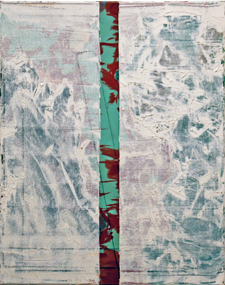 Hartmut Austen, Zip, 2012, oil on canvas, 20 x 16 in. (artwork © Hartmut Austen)
Hartmut Austen, Zip, 2012, oil on canvas, 20 x 16 in. (artwork © Hartmut Austen)
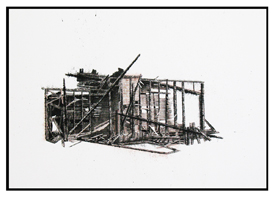 Margi Weir, Frontline/Detroit:Bones 2a, 2010, sumi ink, india ink, and tusche on rag paper, 29 x 40 in. (artwork © Margi Weir)
Margi Weir, Frontline/Detroit:Bones 2a, 2010, sumi ink, india ink, and tusche on rag paper, 29 x 40 in. (artwork © Margi Weir) 
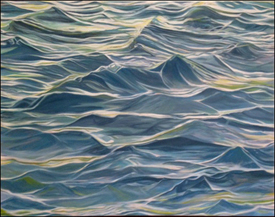 Federicka Foster, Hudson River XIV, 2013, oil on canvas, 48 x 60 in. (artwork © Federicka Foster)
Federicka Foster, Hudson River XIV, 2013, oil on canvas, 48 x 60 in. (artwork © Federicka Foster)
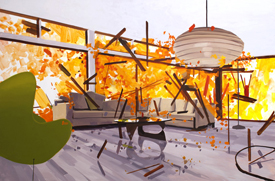 Ben Grasso, Noguchi Table, 2013, oil on panel, 48 x 72 in. (artwork © Ben Grasso)
Ben Grasso, Noguchi Table, 2013, oil on panel, 48 x 72 in. (artwork © Ben Grasso)
 Katerina Lanfranco Boundless, 2013, mixed media and flameworked glass, 8½ x 6½ in. (artwork © Katerina Lanfranco)
Katerina Lanfranco Boundless, 2013, mixed media and flameworked glass, 8½ x 6½ in. (artwork © Katerina Lanfranco)
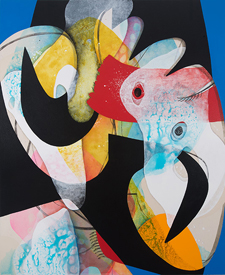 Carrie Moyer, Hook, Line & Sinker, 2012, acrylic, graphite, and glitter on canvas, 72 x 60 in. Collection of the artist (artwork © Carrie Moyer)
Carrie Moyer, Hook, Line & Sinker, 2012, acrylic, graphite, and glitter on canvas, 72 x 60 in. Collection of the artist (artwork © Carrie Moyer)
 Jim Osman, Trunk, 2013, wood and paper, 10 x 10 x 4 in. (artwork © Jim Osman)
Jim Osman, Trunk, 2013, wood and paper, 10 x 10 x 4 in. (artwork © Jim Osman)
 Tim Ripley, War Games, 2013, oil on panel, 16 x 16 in. (artwork © Tim Ripley)
Tim Ripley, War Games, 2013, oil on panel, 16 x 16 in. (artwork © Tim Ripley)
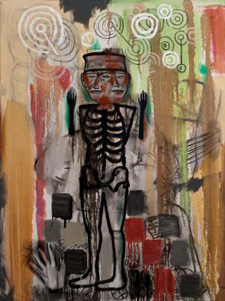 Jaune Quick-to-See Smith, The Face of Ancient America, 2013, oil on canvas, 48 x 36 in. (artwork © Jaune Quick-to-See Smith)
Jaune Quick-to-See Smith, The Face of Ancient America, 2013, oil on canvas, 48 x 36 in. (artwork © Jaune Quick-to-See Smith)
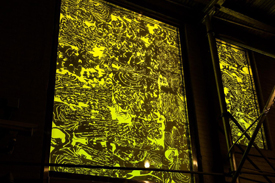 Ann Tarantino, installation view of Topoanalysis, 2013, lasercut paper on glass, dimensions variable (artwork © Ann Tarantino)
Ann Tarantino, installation view of Topoanalysis, 2013, lasercut paper on glass, dimensions variable (artwork © Ann Tarantino)

 Invitation card for Idelle Weber: The Pop Years
Invitation card for Idelle Weber: The Pop Years
 Invitation card for Have It All!
Invitation card for Have It All!
 Michael Aurbach, Administrative Spectacle, 2012, mixed media, 8 x 9 x 16 ft. (artwork © Michael Aurbach)
Michael Aurbach, Administrative Spectacle, 2012, mixed media, 8 x 9 x 16 ft. (artwork © Michael Aurbach)
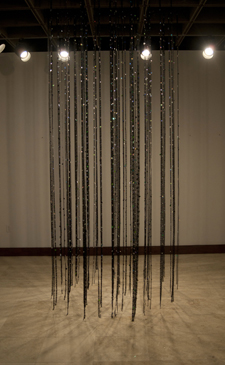 Kelly Sturhahn, Night Fall, 2013, black lace with handsewn sequins, 16 x 5 x 5 ft. (artwork © Kelly Sturhahn)
Kelly Sturhahn, Night Fall, 2013, black lace with handsewn sequins, 16 x 5 x 5 ft. (artwork © Kelly Sturhahn)
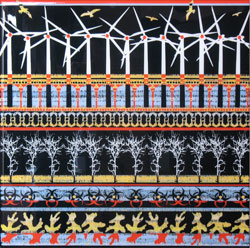 Margi Weir, Antimacassar 4, 2012, acrylic, vinyl, and resin on panel, 48 x 40 in. (artwork © Margi Weir)
Margi Weir, Antimacassar 4, 2012, acrylic, vinyl, and resin on panel, 48 x 40 in. (artwork © Margi Weir)
 Julie Green, installation view of The Last Supper: 500 Plates, 2000–13 (ongoing), cobalt blue on kiln-fired ceramics, 8 x 35 ft. (artwork © Julie Green; photograph by Richard Herskowitz)
Julie Green, installation view of The Last Supper: 500 Plates, 2000–13 (ongoing), cobalt blue on kiln-fired ceramics, 8 x 35 ft. (artwork © Julie Green; photograph by Richard Herskowitz)
 Hazel Antaramian Hofman, Akhbar Shoes II, 2012, charcoal and pastel, 24 x 18 in. (artwork © Hazel Antaramian Hofman)
Hazel Antaramian Hofman, Akhbar Shoes II, 2012, charcoal and pastel, 24 x 18 in. (artwork © Hazel Antaramian Hofman)
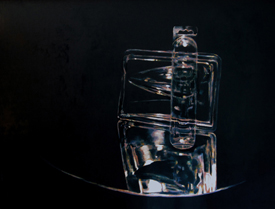 Michael Ryan, Preventative Measures, 2012, oil on linen, 36 x 48 in. (artwork © Michael Ryan)
Michael Ryan, Preventative Measures, 2012, oil on linen, 36 x 48 in. (artwork © Michael Ryan) 
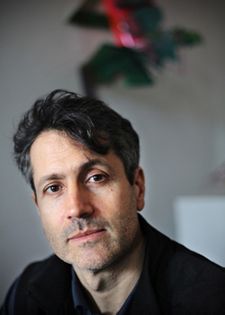 Luca Buvoli (photograph by Keke Keukelaar)
Luca Buvoli (photograph by Keke Keukelaar)
 Jean Robertson
Jean Robertson
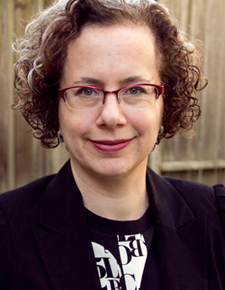 Rachel Schreiber
Rachel Schreiber
 Peter Barnet
Peter Barnet
 Ugochukwu-Smooth Nzewi
Ugochukwu-Smooth Nzewi